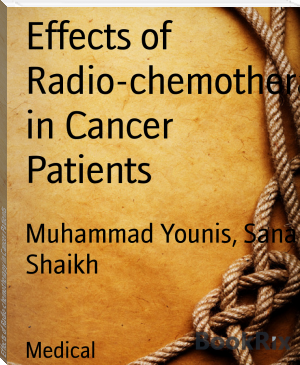Effects of Radio-chemotherapy in Cancer Patients by Muhammad Younis, Sana Shaikh (ereader with android .txt) 📕

- Author: Muhammad Younis, Sana Shaikh
Book online «Effects of Radio-chemotherapy in Cancer Patients by Muhammad Younis, Sana Shaikh (ereader with android .txt) 📕». Author Muhammad Younis, Sana Shaikh
1.1. What is cancer?
Cancer is the uncontrolled growth of abnormal cells in the body. Cancerous cells are also called malignant cells. Treating cancer can be very complicated, and it is difficult for even the most educated patients to be sure they have the best care. Cells are the building blocks of living things. Cancer grows out of normal cells in the body. Normal cells multiply when the body needs them, and die when the body doesn't need them. Cancer appears to occur when the growth of cells in the body is out of control and cells divide too quickly. It can also occur when cells “forget” how to die.[1]
Cancer is a cellular tumor that unlike benign tumors cells, can metastasize and invade the surrounding and distant tissues.[2]
Cancer is derived from a Latin word meaning crab, it is presumed that the word cancer originated from the character of the cancerous cell ‘e’ can originate and adhere and cause pain(like a crab)to any parts of the body.[3]
Cancer cells are characterized by three properties, 1, diminished or unrestricted control of growth 2.invasion of local tissue and. 3.spread or metastasis to other parts of the body.
Agents causing cancer fall into three broad groups radiant energy, chemical compound, and viruses.[4]
Cancer chemotherapy and radiation are used to damage or kill cancer cells. Some of the body’s normal cell including the blood cells, May also be damaged by these treatments. The good news is that your body can repair damage to normal cells.[5]
Nutritional deficiencies, hemolysis, bone marrow failure due to tumor involvement, myelofibrosis, or necrosis could not be systematically investigated in present serial. [6] The use of erythropoietin (epo) in oncologic patients increases Hb levels that improve oxygenation its sensitivity to radiotherapy. [7]
1.2. The terminology used in cancer:
Neoplasia: Neoplasia means news growth and is characterized by unceasing abnormal and excessive proliferation of cells. Neoplasm: The neoplasm (commonly called tumor) is defined as the abnormal mass of the tissue. The growth of ‘e’exceeds and is un co-ordinated with that of the normal tissue, and persists in the same excessive manners after the cessation of the stimuli ‘e’ evoked the change. Oncology: The study of neoplasm (tumor) or cancerous cells is called oncology. When cancer is associated with a tumor then it is termed as malignant tumors or malignancy. The malignant tumors or cancer are destructive and dangerous.
Some important characteristics of cancerous cells or malignant Tumors:
Differentiation of cancers or malignant tumors ranges from differentiation to undifferentiated. It invades and penetrates the surrounding tissues. It metastasizes to the regional lymph nodes and distant organs. The rate of growth of all cancer usually rapid except cancer of cervical ‘e’ grows slowly. Cancerous cells are non-encapsulated. The gross appearance of cancerous cells includes regeneration, necrosis. Ulceration, hemorrhage is also more frequent. Clinically cancerous cells act as parasites and tend to kill the patient whenever it grows. Recurrence is common in malignant tumors. [8]
1.3. Nomenclature of cancerous cells:
Cancer is classified according to the tissue and cell type from which they originate.
Those arising from epithelial cells are called carcinoma (karkino, crab, Greek). Nearly 90% of human cancers are carcinomas. Sarcomas are those derived from connective tissue or muscle cells (sarkos, flesh, oma, and tumor).The enzymes secreted by malignant cells can hydrolyze the adhesive proteins, weakening the interaction of the cell with the substratum. [9]
1.4. Types of cancer:
There are many different kinds of cancers. Cancer can develop in almost any organ or tissue. [2]
Types of Cancer Classified by Body System:
Blood Cancer: The cells in the bone marrow that give rise to red blood cells, white blood cells, and platelets can sometimes become cancerous. These cancers are leukemia or lymphoma.
Leukemia Lymphoma Multiple Myeloma Waldenstrom's MacroglobulinemiaBone Cancer: Bone cancer is a relatively rare type of cancer that can affect both children and adults, but primarily affects children and teens. There are several types of bone cancer, but the most common types are:
Ewing's Sarcoma OsteosarcomaBrain Cancer: Brain tumors can be malignant (cancerous) or benign (non-cancerous). They affect both children and adults. Malignant brain tumors don't often spread beyond the brain. However, other types of cancer have the ability to spread to the brain. Types of brain cancer include:
Adult Brain Tumor Brain Stem Glioma, Childhood Cerebellar Astrocytoma, Childhood Cerebral Astrocytoma/Malignant Glioma, Childhood Ependymoma, Childhood Medulloblastoma, Childhood Supratentorial Primitive Neuroectodermal Tumors and Pineoblastoma, Childhood Visual Pathway and Hypothalamic Glioma, ChildhoodBreast Cancer: Breast cancer is a common type of cancer that affects women and much less commonly, men. More than 200,000 women are diagnosed with breast cancer in the United States each year. Types of breast cancer include, but are not limited to:
Ductal carcinoma in situ Lobular carcinoma in situ Inflammatory breast cancer Paget's disease of the nipple Invasive types of breast cancerDigestive/Gastrointestinal Cancers: This is a broad category of cancer that affects everything from the esophagus to the anus. Each type is specific and has its own symptoms, causes, and treatments.
Anal Cancer Bile Duct Cancer, Extrahepatic Carcinoid Tumor, Gastrointestinal Colon Cancer Esophageal Cancer Gallbladder Cancer Liver Cancer, Adult Primary Liver Cancer, Childhood Pancreatic Cancer Rectal Cancer Small Intestine Cancer Stomach (Gastric) CancerEndocrine Cancers: The endocrine system is an instrumental part of the body that is responsible for glandular and hormonal activity. Thyroid cancer is the most common of the endocrine cancer types and generally, the least fatal.
Adrenocortical Carcinoma Carcinoid Tumor, Gastrointestinal Islet Cell Carcinoma (Endocrine Pancreas) Parathyroid Cancer Pheochromocytoma Pituitary Tumor Thyroid CancerEye Cancer: Like other organs in the human body, the eyes are vulnerable to cancer as well. Eye cancer can affect both children and adults.
Melanoma, Intraocular RetinoblastomaGenitourinary Cancers: These types of cancer affect the male genitalia and urinary tract.
Bladder Cancer Kidney (Renal Cell) Cancer Penile Cancer Prostate Cancer Renal Pelvis and Ureter Cancer, Transitional Cell Testicular Cancer Urethral Cancer Wilms' Tumor and Other Childhood Kidney Tumors
Gynecologic Cancers: This group of cancer types affects the organs of the female reproductive system. Specialized oncologists called gynecologic oncologists are recommended for treating gynecologic cancer.
Head and Neck Cancer: Most head and neck cancers affect moist mucosal surfaces of the head and neck, like the mouth, throat, and nose. Causes of head and neck cancer vary, but cigarette smoking plays a role. Current research suggests a strong HPV link in the development of some head and neck cancer.
Hypopharyngeal Cancer Laryngeal Cancer Lip and Oral Cancer Metastatic Squamous Neck Cancer Nasopharyngeal Cancer Oropharyngeal Cancer Paranasal Sinus and Nasal Cavity Cancer Parathyroid Cancer Salivary Gland CancerRespiratory Cancers: Cigarette smoking is the primary cause for cancer affecting the respiratory system. Exposure to asbestos is also a factor.
Lung Cancer, Non-Small Cell Lung Cancer, Small Cell Malignant Mesothelioma Thymoma and Thymic CarcinomaSkin Cancers: Non-melanoma skin cancer is the most common type of cancer among men and women. Exposure to the UV rays of the sun is the primary cause for non-melanoma skin cancer and also melanoma.
Cutaneous T-Cell Lymphoma Kaposi's Sarcoma Melanoma Merkel Cell Carcinoma Non-Melanoma Skin Cancer[10]1.5. CAUSES:
carcinogens :
A carcinogen is any substance or radiation that is an agent directly involved in the exacerbation of cancer or in the increase of its propagation. This may be due to the ability to damage the genome or to the disruption of cellular metabolic processes. Common examples of carcinogens are
Alpha particles Gamma rays X- rays UV-rays Benzo[a] pyrene Nitrosamine Formaldehyde Vinyl chloride [11][12] Aflatoxin B1 Hepatitis B virus Human papilloma virus Asbestos, Benzene Kepon[13]1.6. SYMPTOMS:
Roughly, cancer symptoms can be divided into three groups:
Local symptoms: unusual lumps or swelling (tumor), hemorrhage (bleeding), pain and/or ulceration. Compression of surrounding tissues may cause symptoms such as jaundice (yellowing the eyes and skin). Symptoms of metastasis (spreading): enlarged lymph nodes, cough, and hemoptysis, hepatomegaly (enlarged liver), bone pain, fracture of affected bones and neurological symptoms. Although advanced cancer may cause pain, it is often not the first symptom. Systemic symptoms: weight loss, poor appetite, fatigue and cachexia (wasting), excessive sweating (night sweats), anemia and specific paraneoplastic phenomena, i.e. specific conditions that are due to active cancer, such as thrombosis or hormonal changes.[14]1.7. DIAGNOSIS:
A cancer diagnosis is difficult to cope with. It is important, however, that discuss the type, size, and location of cancer with the doctor when he diagnosed it. He will also tell you about treatment options, along with their benefits and risks.
Biopsy of the tumor Blood chemistries Bone marrow biopsy (for lymphoma or leukemia) Chest x-ray Complete blood count (CBC) CT scan
Most cancers are diagnosed by biopsy. Depending on the location of the tumor, the biopsy may be a simple procedure or a serious operation. Most patients with cancer have CT scans to determine the exact location and size of the tumor or tumors. [2]
1.8. ROLE OF NUTRITION IN CANCER:
Diet has a greater influence on some types of cancer than others. The strongest links are with some cancers of the gastrointestinal tract e.g. of the mouth, throat, stomach and large bowel (colon). Dietary factors may protect against or reduce the risk of cancer. For example, fruit and vegetables, consumed regularly, are thought to help reduce risk, whereas a low fiber intake or high alcohol intake increase risk. Diet is only usually one of several factors involved. [15] It has been estimated that 30–40 percent of all cancers can be prevented by lifestyle and dietary measures alone.The consensus on diet and cancer is that obesity increases the risk of developing cancer.[16] First, we will give you general guidelines, followed by in-depth information on a diet to fight cancer. To begin, we must warn you that a dramatic change in your diet can dump dangerously large amounts of cellular waste into your bloodstream, therefore you must detoxify your system before and during the initial stages of your diet.[17] Avoiding smoking, eating a balanced diet with plenty of fruit and vegetables and moderate amounts of red and processed meats, keeping body weight within the healthy range for height and keeping alcohol consumption to a moderate level, all help to reduce the risk of cancer.[15]
FRUITS:
Ten percent of your diet should be fruit. Eat fruit alone as a small meal or between meals, or at least one-half hour before a meal, never after. Keep citrus fruit to a minimum. Citrus puts your body into an acidic state. If you are battling cancer, keep your citrus to a minimum. Get your vitamin C from supplements. [17] There is also moderate evidence that higher consumption of fruit can reduce lung cancer risk although the major risk factor is smoking. [15]
VEGETABLES:
A minimum of fifty percent of your diet should be veggies. Fresh vegetable juices are a must. The best cancer-fighting juice is carrot juice. It is high in beta-carotene and high in alpha-carotene, an





Comments (0)